设计要求:针对字符集 A 及其各字符的频率值(可统计获得)给出其中给字符
哈夫曼编码,并针对一段文本(定义在 A 上)进行编码和译码,实现一个哈夫
曼编码/译码系统。
#include
#include
#include
#include
#include
#define NN 10000
#define M 2*NN-1
#define IN 0
#define OUT 1
#define MAX_INT 32767
#define PRINTLN printf("\n\n\n\n\n\n\n\n");
typedef struct
{
int wi;
char c;
int tag;
int parent, lchild, rchild;
}huffmtype;
typedef char* encodetype[NN+1];
typedef struct
{
char c;
int times;
}codetype;
void PRINT()
{
PRINTLN;
printf("\t\t\t
printf("\t\t\t
printf("\t\t\t
printf("\t\t\t
}
Huffman 编/译码器\n");
====================\n");
1.编码 2.译码 3.退出\n\n");
>>选择:");
FILE* OpenFile(char filename[20], char type[3])
�
{
}
FILE *fp = NULL;
if((fp = fopen(filename, type)) == NULL) exit(1);
return fp;
int ReadCode(codetype* code, FILE* fp)
{
char c;//保存某次从文件中读入字符-
int n = 1;//记录首次出现字符在数组中的下标-
int i;//循环变量-
int cnt = 1;
int tag;//标志某次读入字符是否为首次出现字符,tag=1 表示是首次出现;tag=0
表示本次读入字符为已有字符
while((c = fgetc(fp)) != EOF)//当文件没有结束时读入字符-
{
//从 fp 指向文件中读取字符,存入字符变量 c 中-
tag = 1;//假设本次读取字符为首次出现字符-
for(i = 1; i < n; i++)
{
if(c == code[i].c)//如果本次读入字符为存储在下标为 i 已有字符-
{
code[i].times++;//权值加 1-
tag = 0;//标记本字符为已有字符-
break;//在已有数组元素中找到本次读入字符,结束 for(;;)循环-
}
}
if(tag)//当本字符为首次出现字符时-
{
code[n].c = c;//把改字符存入 n 指向的数组单元中-
code[n].times = 1;//记字符出现次数为 1-
n++;//n 指向下一个数组地址-
}
}
return n - 1;//返回文件中字符集合的元素个数-
}
�
void InitHuffmanTree(huffmtype* huffmtree, int real_n, int real_m)//初始化-
{
int i;
for(i = real_n; i <= real_m; i++)
{
huffmtree[i].wi = 0;
huffmtree[i].c = 0;
huffmtree[i].tag = IN;
huffmtree[i].lchild = huffmtree[i].rchild = huffmtree[i].parent = 0;
}
}
void ReadDataWeight_Init(huffmtype* huffmtree, codetype* code, int real_n)//
获取权值及数值域值-
{
int i;
for(i = 1; i <= real_n; i++)//-
{
huffmtree[i].wi = code[i].times;
huffmtree[i].c = code[i].c;
huffmtree[i].tag = IN;
huffmtree[i].lchild = huffmtree[i].rchild = huffmtree[i].parent = 0;
}
}
int LeastNode(huffmtype *huffmtree, int max_i)//找到最小权值节点地址-
{
int i;
int least_i;
int max = MAX_INT;
for(i = 1; i <= max_i; i++)//遍历 1 到 max_i 节点-
{
if(huffmtree[i].wi < max && huffmtree[i].tag == IN)//若节点权值比 max 小并且
在森林中-
{
}
max = huffmtree[i].wi;//刷新 max 值-
least_i = i;//保存当前节点地址-
�
}
huffmtree[least_i].tag = OUT;//将最小权值节点从森林中移除-
return least_i;//返回最小节点地址
}
void Slect(huffmtype *huffmtree, int max_i, int *x1, int *x2)//找到权值最小的两
个节点,并将其下标值保存在 x1,x2 中-
{
*x1 = LeastNode(huffmtree, max_i);//计算合法最下权值下标-
*x2 = LeastNode(huffmtree, max_i);//
}
void CreatHuffmanTree(huffmtype* huffmtree, int real_n, int real_m)//创建哈弗
曼树-
{
int i;
int x1, x2;
for(i = real_n + 1; i <= real_m; i++)
{
Slect(huffmtree, i-1, &x1, &x2);//找到权值最小的两个节点,并将其下标值保
存在 x1,x2 中-
huffmtree[i].wi = huffmtree[x1].wi + huffmtree[x2].wi;//计算双气节点权值-
huffmtree[x1].parent = huffmtree[x2].parent = i;//计算双亲节点地址-
huffmtree[i].lchild = x1; huffmtree[i].rchild = x2;//计算双亲节点左右孩子地址-
}
}
void Encode(huffmtype *huffmtree, encodetype encode, int real_n)//依据已创
建的 HuffmanTree 对字符进行编码-
{
char *cd;
int i;
int start;
int c, p;
�
cd = (char*)malloc(real_n*sizeof(char));//cd 用来存放某次运行时当前字符编码
-
cd[real_n - 1] = '\0';//作为字符结束符-
for(i = 1; i <= real_n; i++)//对 real_n 个节点进行遍历-
{
start = real_n-1;
c = i;//c 保存当前节点地址(下标)-
p = huffmtree[i].parent;//p 保存当前节点双亲地址-
while(p)
{
start--;//计算编码的起始地址-
if(huffmtree[p].lchild == c)//若当前节点为其双亲的左孩子-
{
}
cd[start] = '0';//编码为 0-
else//若为右孩子-
{
}
cd[start] = '1';//编码为 1-
c = p;//节点前进-
p = huffmtree[p].parent;//计算前进后节点双亲节点地址-
}
�
encode[i] =(char*)malloc((real_n - start)*sizeof(char));//申请空间用于存放编
码-
strcpy(encode[i], &cd[start]);//将本次编码存入 encode 数组中-
}
free(cd);//释放闲置存储空间-
}
void WriteToFile(FILE *fp, encodetype encode, codetype *code, int real_n,
char *readfile)//将编码输出到文件
{
int i;
char cod[NN];
FILE *fp2;
char c;
int cnt = 1, j;
fp2 = fopen(readfile, "rt");
while((c = fgetc(fp2)) != EOF)
{
}
cod[cnt++] = c;
fclose(fp2);
for(i = 1; i < cnt; i++)
{
�
for(j = 1; j <=real_n; j++)
{
}
if(cod[i] == code[j].c)
{
}
break;
fprintf(fp, "%s", encode[j]);
}
fclose(fp);
}
int IsError(FILE *fp)//对打开文件进行出错判断-
{
if(!fp)
{
}
printf("\t\t\t
×打开文件错误\n");
printf("\t\t\t 任意键返回主菜单");
getch();
return 1;//文件打开失败-
return 0;//文件打开成功-
�
}
void GetFilename(char *filename, char type[13])//得到用户输入相关文件名
{
}
system("cls");
PRINTLN;
printf("\t\t\t %s:", type);
fflush(stdin);
gets(filename);
int PutIntoCode(codetype code[], huffmtype huffmtree[])//编码函数
{
encodetype encode;
FILE* fp;//文件类型指针-
int real_n;//用来存放字符集长度-
char readfile[20];//从 readfile 文件中读取字符,写入到 writefile 文件中-
GetFilename(readfile, "读取源文件");//从键盘读取文件名-
fp=OpenFile(readfile, "rt");//打开待编码文件-
if(IsError(fp))//判断是否正确打开文件-
{
}
return 0;//打开文件失败,返回主菜单-
�
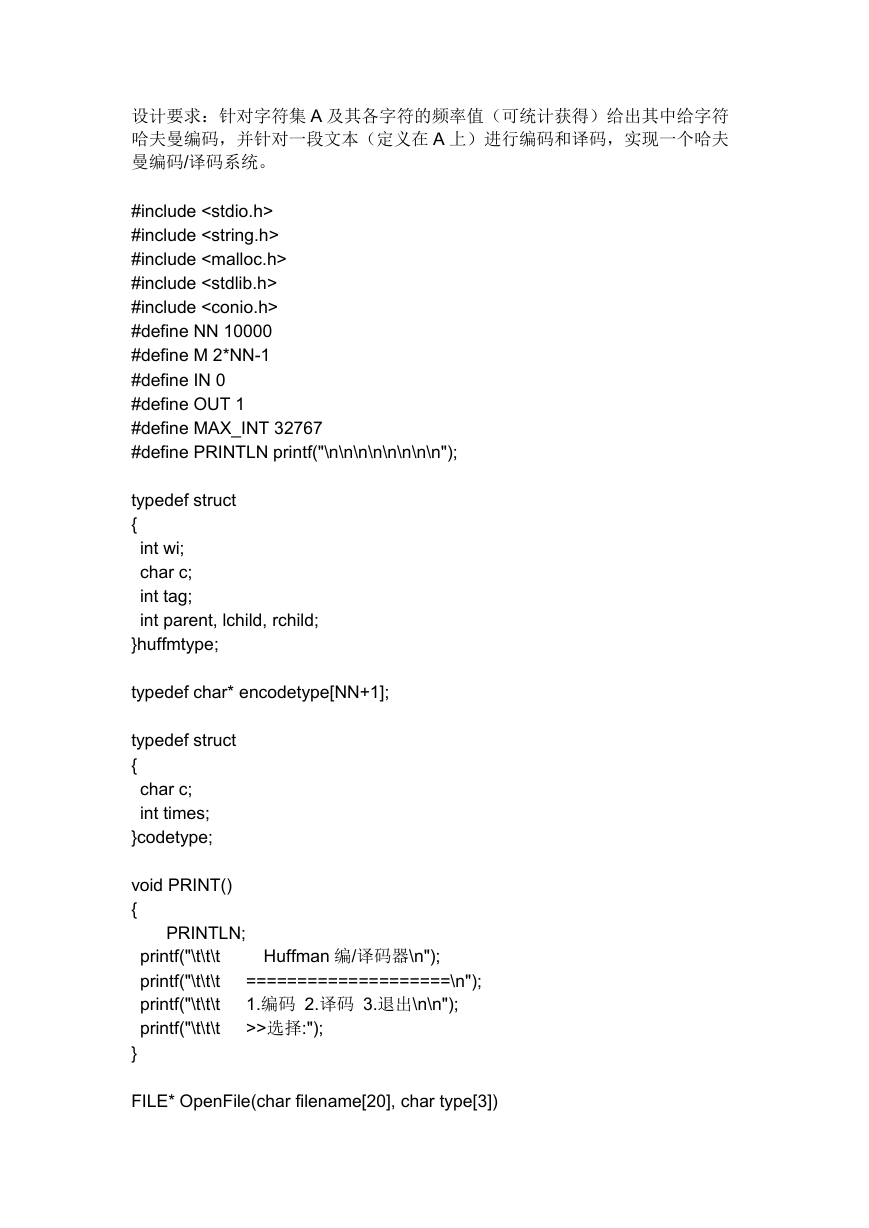
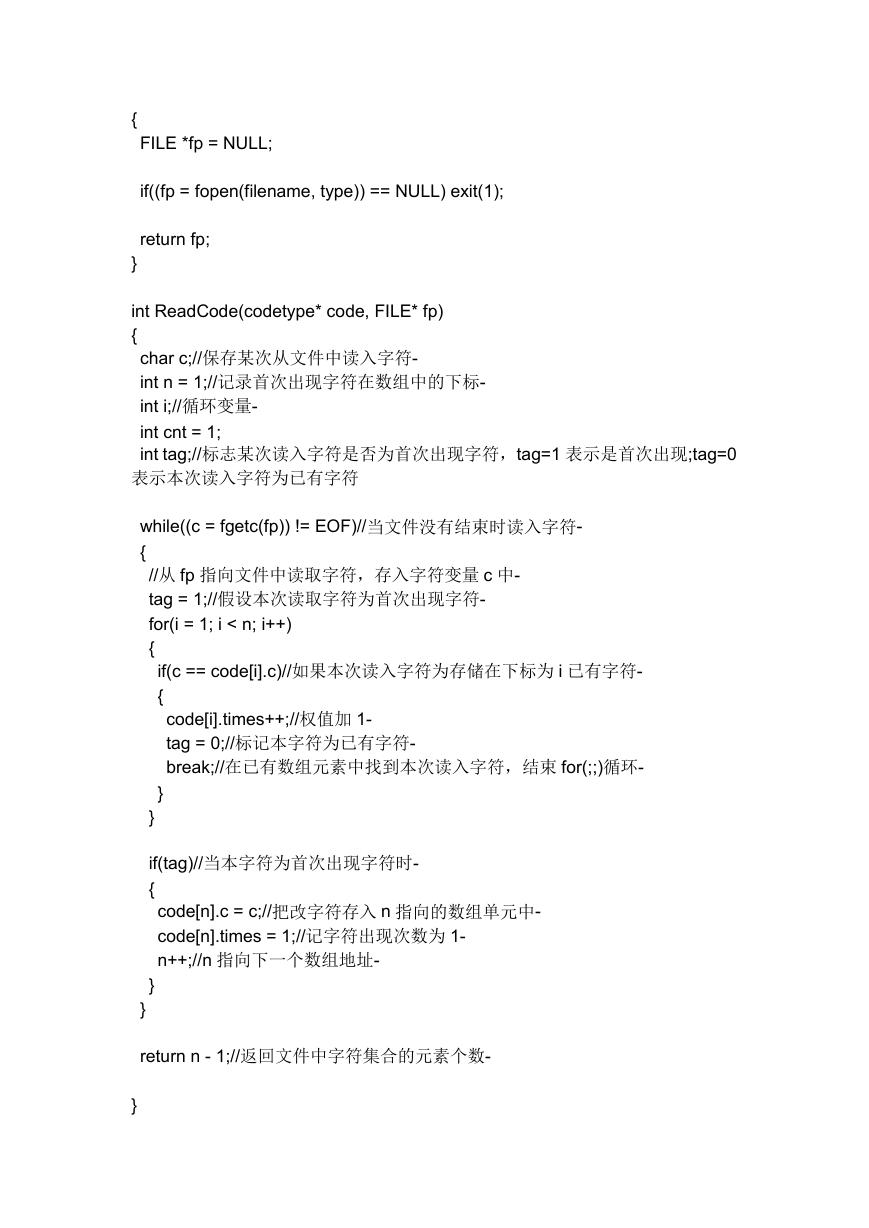
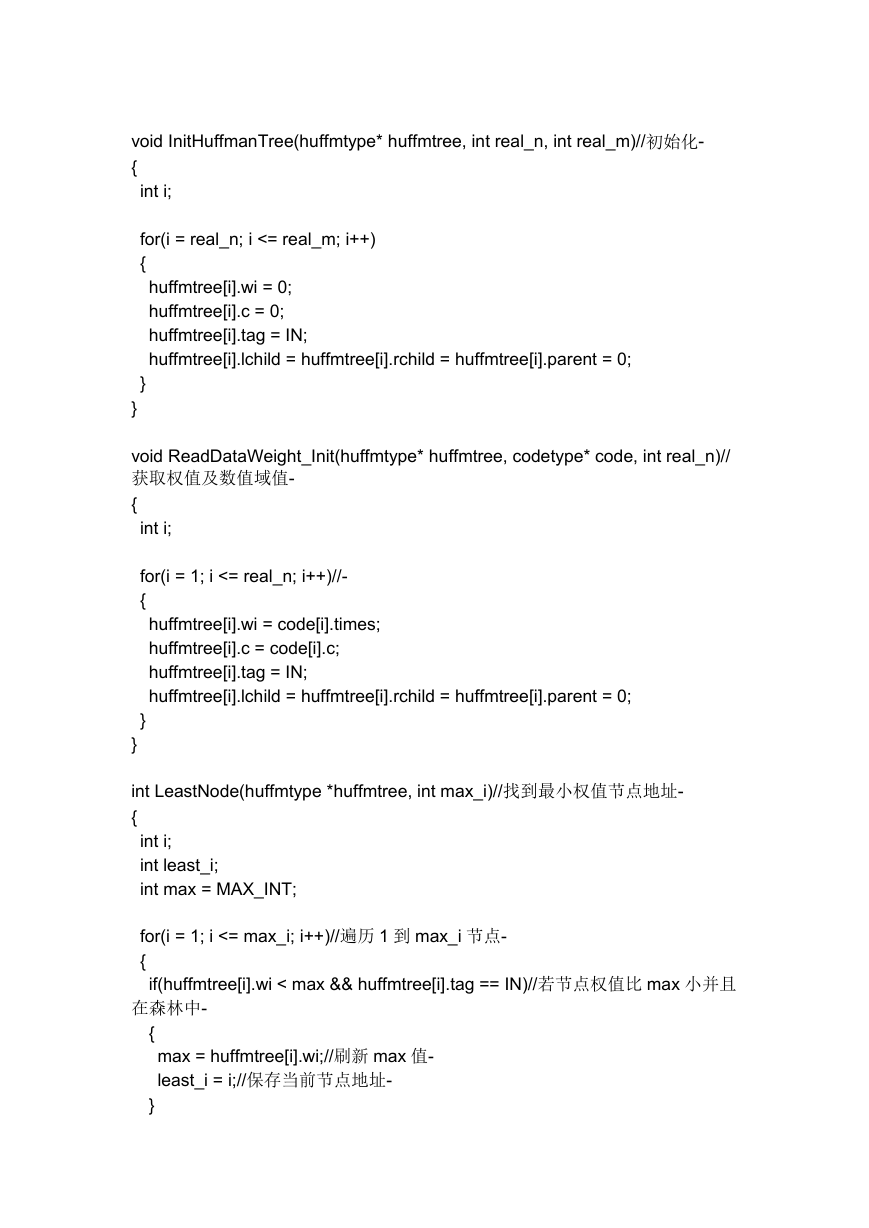
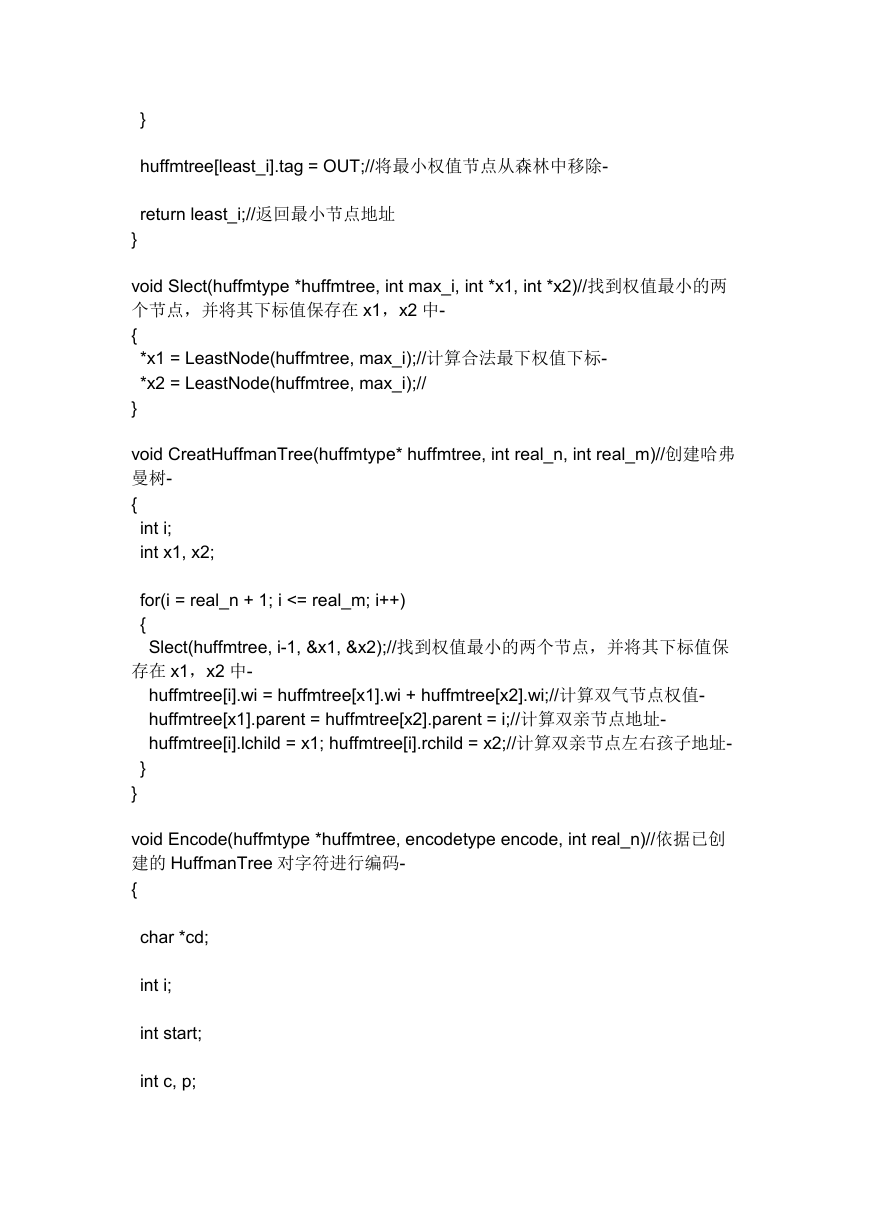
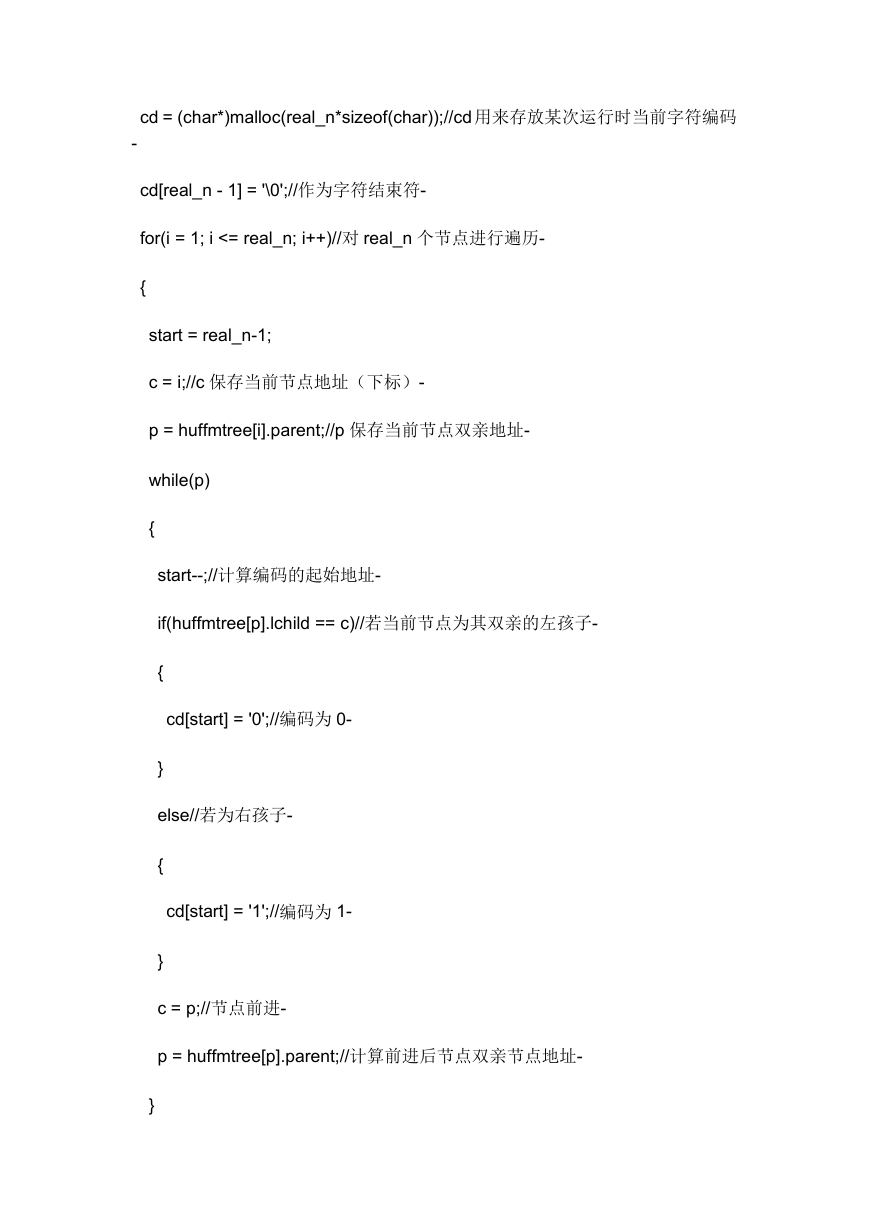
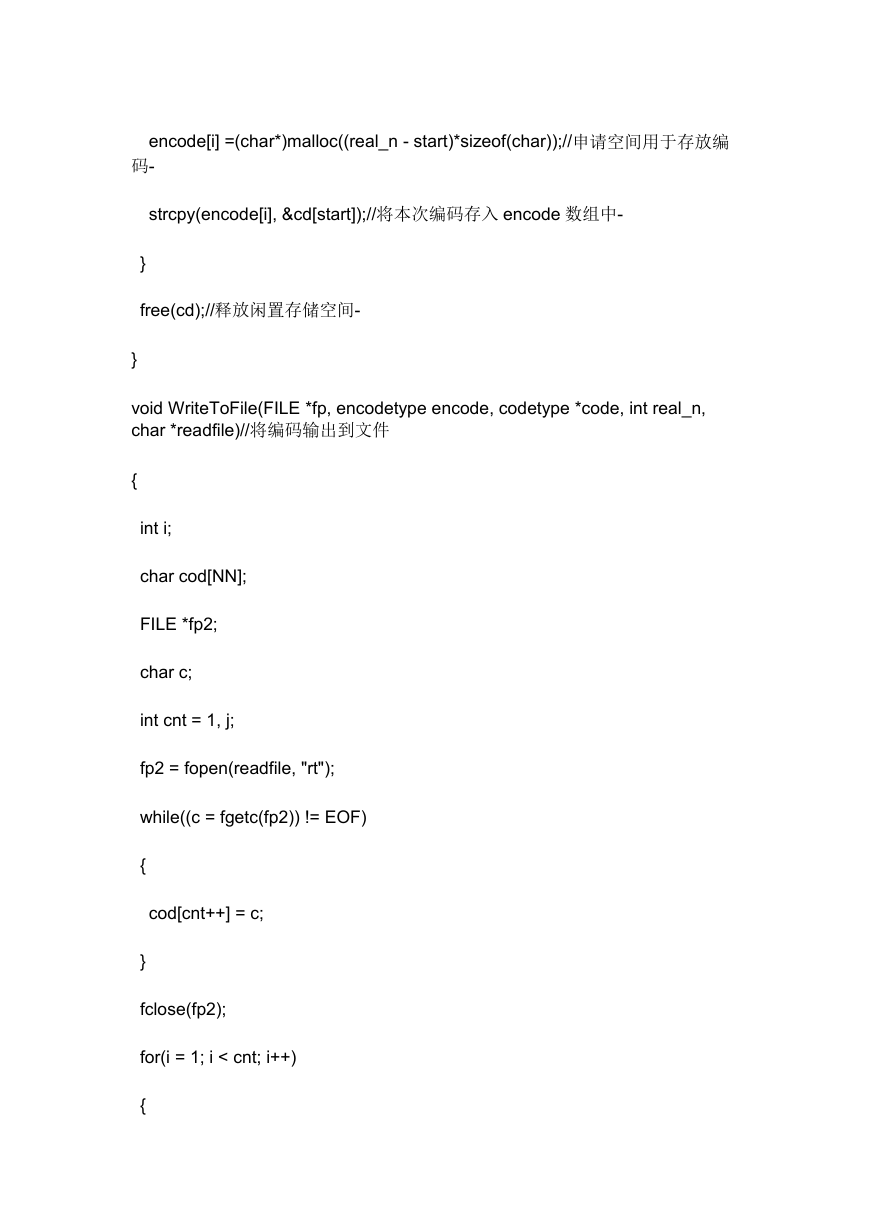
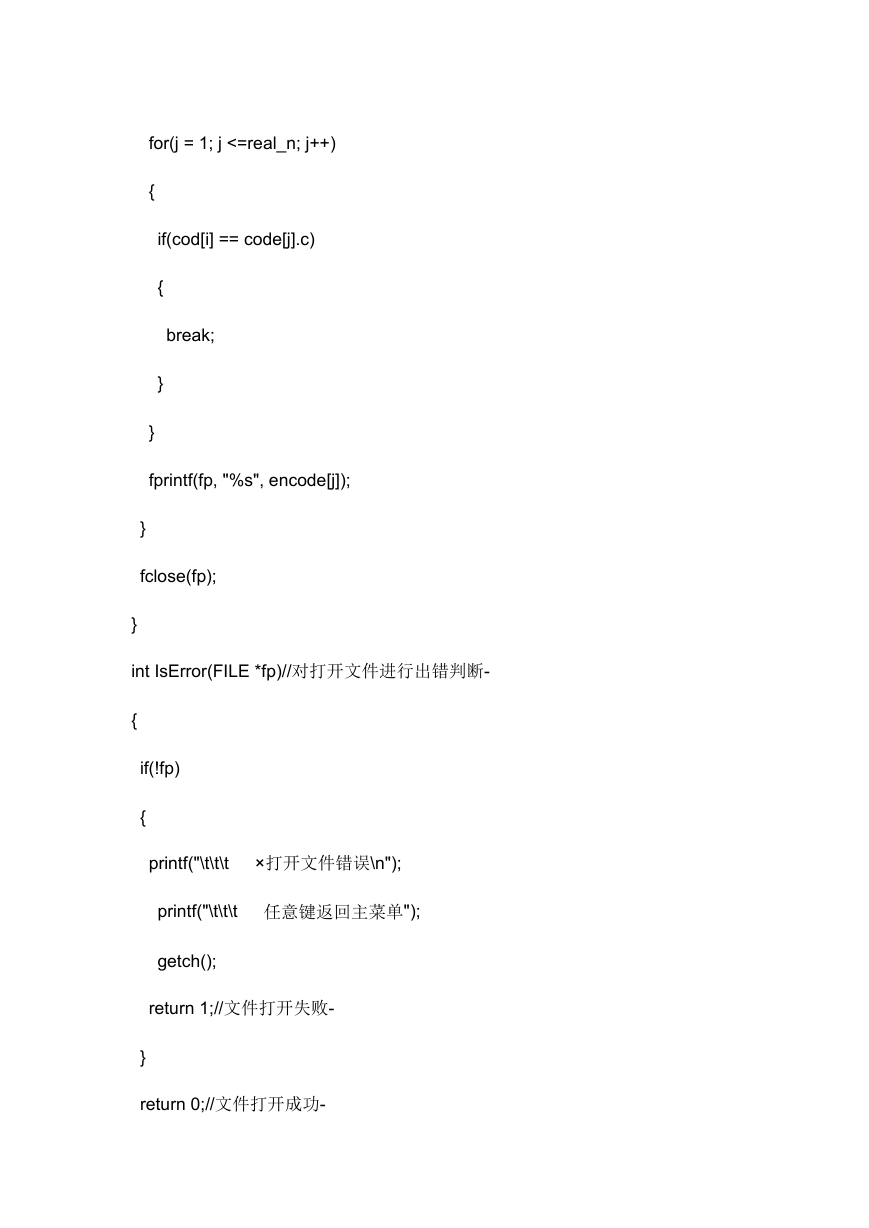
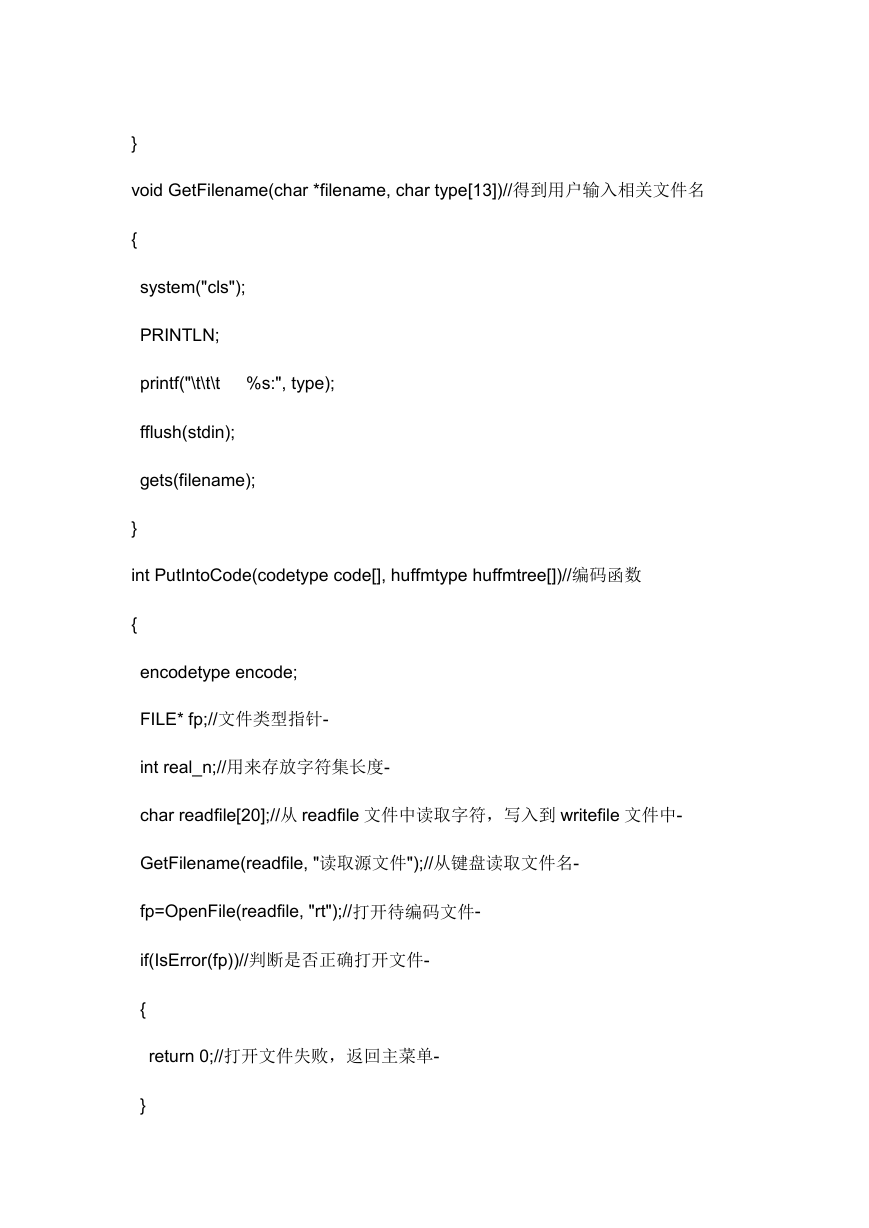








 2023年江西萍乡中考道德与法治真题及答案.doc
2023年江西萍乡中考道德与法治真题及答案.doc 2012年重庆南川中考生物真题及答案.doc
2012年重庆南川中考生物真题及答案.doc 2013年江西师范大学地理学综合及文艺理论基础考研真题.doc
2013年江西师范大学地理学综合及文艺理论基础考研真题.doc 2020年四川甘孜小升初语文真题及答案I卷.doc
2020年四川甘孜小升初语文真题及答案I卷.doc 2020年注册岩土工程师专业基础考试真题及答案.doc
2020年注册岩土工程师专业基础考试真题及答案.doc 2023-2024学年福建省厦门市九年级上学期数学月考试题及答案.doc
2023-2024学年福建省厦门市九年级上学期数学月考试题及答案.doc 2021-2022学年辽宁省沈阳市大东区九年级上学期语文期末试题及答案.doc
2021-2022学年辽宁省沈阳市大东区九年级上学期语文期末试题及答案.doc 2022-2023学年北京东城区初三第一学期物理期末试卷及答案.doc
2022-2023学年北京东城区初三第一学期物理期末试卷及答案.doc 2018上半年江西教师资格初中地理学科知识与教学能力真题及答案.doc
2018上半年江西教师资格初中地理学科知识与教学能力真题及答案.doc 2012年河北国家公务员申论考试真题及答案-省级.doc
2012年河北国家公务员申论考试真题及答案-省级.doc 2020-2021学年江苏省扬州市江都区邵樊片九年级上学期数学第一次质量检测试题及答案.doc
2020-2021学年江苏省扬州市江都区邵樊片九年级上学期数学第一次质量检测试题及答案.doc 2022下半年黑龙江教师资格证中学综合素质真题及答案.doc
2022下半年黑龙江教师资格证中学综合素质真题及答案.doc